Tonbak Basic Lesson
This goblet shaped drum is the main accompagnying percussion instrument in Iranian Art music. It has the shape of a wine glass. Very characteristic for the sound is the Riz-E-Por. This roll is produced with the fingers of both hands. The playing style of this instrument became more rich and expressive by the work of great tonbak masters in the last century, especially Ostad Hossain Tehrani whom man consider the father of modern tonbak playing.
Position
Place the neck of the instrument on your left leg. The left arm lies on the body of the drum so that the fingers reach the skin comfortably. Most of the tonbak strokes are done mainly by movements from the wrist, not only the fingers.
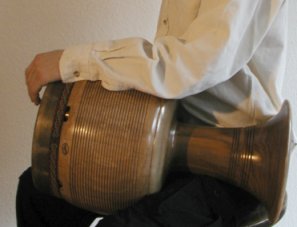
Ton
The bass tone on the tonbak is done by the joined fingertips of your cupped right hand. The heel of your hand hits the rim of the drum and the fingertips the skin. They bounce off immedialtely.

Bak
This stroke is done with the ring-finger, or with middle- and ringfinger. Straighten your right hand´s fingers and hit the edge of the skin. For the left hand bak, raise your hand (but not the arm) from the drum, execute a fast downwards-motion and “throw” your fingers to strike the rim. Be careful with both hands not to press the fingers on the skin.
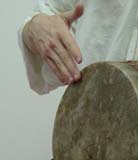
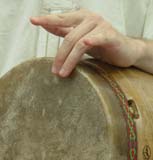
Snapping (pelang)
The technique for this stroke is a little bit similar to snapping your finger. It can be done with all fingers, but for now use the most common ones, the ring and middle finger of the left hand. The finger is placed against the thumb and then snapped against the rim. You can use the ring and middle finger to do two strokes in a row.
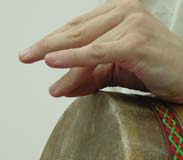
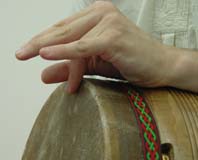
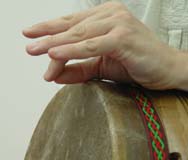
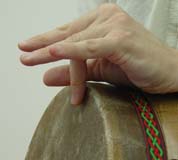
The middle stroke (Meyaneh)
To execute this stroke with the right hand, place your thumb on the side of the drum to give your hand stability. Then hit the drum with your ringfinger so that 2/3 of the finger hit the skin. The movement or the left hand is similar to the left hand Bak, only that you hit the drum also with 2/3 of your ringfinger. The motion comes from the wrist.
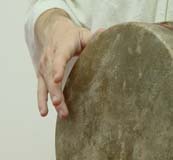
The nine-finger-roll (riz-e-por)
This is probably the most characteristic sound of the tonbak and the technique is quite tricky to master. Executed in the correct way, this technique gives an even roll, comparable to a roll on a snare drum. You swing your hand towards the skin with your fingers loose. With the right hand you hit with the thumb and than with the other fingers, with the left hand only the fingers hit the drum. You don´t think individually about every finger, but make only one movement from the wrist. You should get a kind of “prrr”-sound. Executed fast with both hands, it is possible to produce the “roll”-sound.
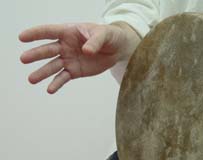
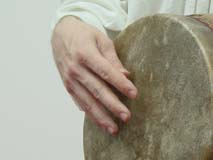
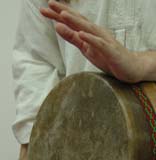
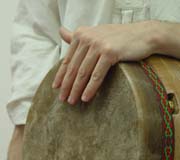
Eshareh
The Eshareh is like a pickup note before a stroke. The timing is hard to describe, it is very much a matter of feeling to play the eshareh fluently into the next stroke. There are different ways of playing. One is like a mini riz-e-por. Don´t play it continously, just once the right, once the left hand and then come to the main stroke. Another technique is to use the left middle and index finger. Put the index finger on top of the middle finger and “let it drop” onto the skin. Then move the middle finger up/sidewards and snap the index finger to get the second sound:
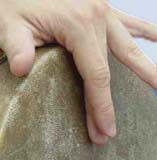
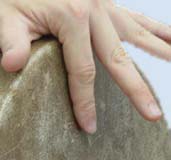
(for a detailed description of the strokes check the tombak network and an article called “the basic strokes of the tonbak” written by Matt Hannafin: http://www.donbak.co.uk/Articles/BasicStrokesofTombak.htm)
watch a demonstration of the basic strokes:
![]()
Tonbak Notations
The right hand bak is substituted by a meyaneh.

![]()
Now use pelangs (snaps) with the left ringfinger instead of baks.

![]()
You can put the eshareh before the first beat.

![]()
If you change the pattern by adding another stroke, you have to change the fingering. Now there are two strokes of the left hand behind each other. Both of them are executed with the right ringfinger while the thumb rests on the side of the drum.

![]()
Once you are familiar with this rhythm, you can extend it by adding variations. In this variation you add the roll (riz-e-por) in the 3rd bar.

![]()
The next rhythm is in 4/4. It is introduced step by step, starting simple and adding more and more notes:

![]()

![]()

![]()

![]()

![]()
and now we substitute the last ton:

![]()
© David Kuckhermann 2006


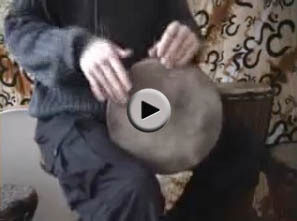


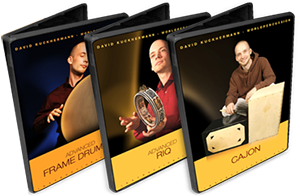
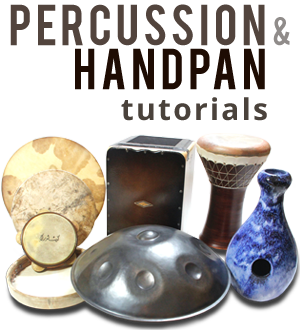
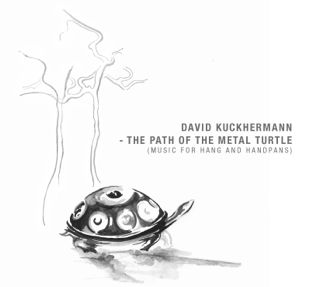
4 Comments